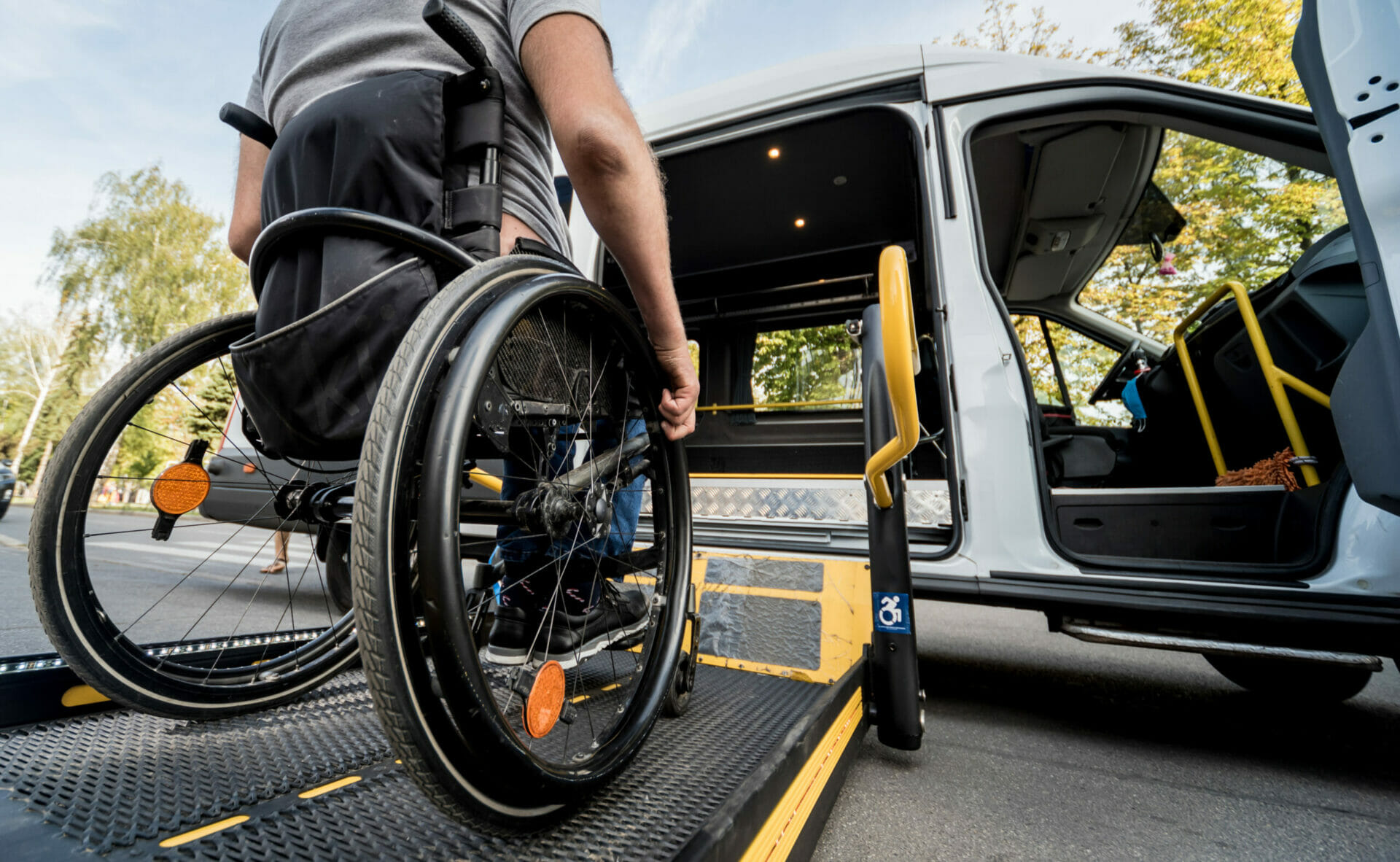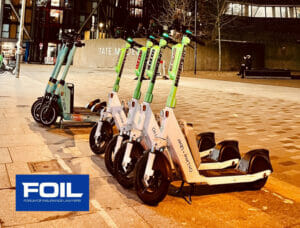It is difficult to obtain a reliable figure for the number of wheelchair users in a country or region because users acquire their wheelchairs from various sources including public and private health services, charities and through private purchases.
Mobility, independence, and the use of motor vehicles to permit access to education, work and leisure activities is as important for wheelchair users as it is for anyone else. Wheelchair users may be drivers or passengers in private cars or vans, buses, minibuses and taxis.
Here we discuss the regulatory requirements when using a wheelchair as a vehicle seat, together with some of the technical factors involved in the event of a collision. Of course, individual wheelchair user’s needs are likely to be unique, so a one-size-fits-all approach is not an option. The safety of any vehicle occupant is paramount and the decision to use a wheelchair as a vehicle seat is a decision for the individual along with healthcare professionals.
Types of System
The design of vehicle seats has developed over many years to improve their performance in the event of a collision, including ‘anti-submarine’ features to prevent the occupant sliding underneath the seat belt. In addition, seat belt pre-tensioners and airbag systems form passive safety systems to reduce the risk of injury in a collision. It is therefore generally safer and preferable for a wheelchair user to transfer from their wheelchair into a vehicle seat when possible.
Unfortunately, it is not always possible to transfer into a vehicle seat and therefore it becomes necessary to consider using a wheelchair as a vehicle seat by anchoring the wheelchair within a wheelchair accessible vehicle (WAV) and using a suitable seat belt. There are two primary methods of anchoring the wheelchair within the vehicle; either a ‘docking system’ or a ‘wheelchair tiedown and occupant restraint system’ (WTORS):
- With a docking system, a socket-type anchor point is permanently mounted to the floor of the vehicle and a corresponding locking plate or pin on the wheelchair engages in this socket to secure the wheelchair to the vehicle. A seat belt is then used to restrain the wheelchair occupant in the normal way in case of a collision.
- With a WTORS, the wheelchair is secured to the floor of the vehicle using a series of straps, or ‘tiedowns’. A seat belt is then used to restrain the wheelchair occupant in the normal way in case of a collision.
Once it is set up, a docking system will be relatively straightforward to use in combination with its associated wheelchair, or wheelchairs, due to the permanent nature of the anchor point and corresponding features on the wheelchair. This allows the occupant restraint to be optimally positioned for the wheelchair’s position. Docking systems may also incorporate features designed to alert users to incorrect use such as a warning if the wheelchair is not correctly engaged in the anchor point.
The requirement for a vehicle mounted anchor point and specific corresponding locking feature on the wheelchair, makes the use of docking systems better suited to specific wheelchair-vehicle combinations such as personal vehicles, especially when a vehicle is designed to be ‘drive from wheelchair’ (DFW). This system is less likely to be found on vehicles that may be required to transport a range of different wheelchair users such as taxis or minibuses.
WTORS, on the other hand, provide more versatility to be reconfigured for use with a range of different wheelchairs, and can potentially be removed from the vehicle when not in use. They are used for transporting wheelchair users as passengers and require an assistant to operate so, cannot be operated by solo wheelchair users. Although there are some design features that can highlight incorrect use, there are more elements to be configured each time a wheelchair is loaded onto a vehicle. Therefore, they require sufficient operator ability to ensure their correct use.
The rest of this article will focus on the use of WTORS. The requirements and test methods for WTORS are covered by ISO 10542-1:2012 ‘Wheelchair tiedown and occupant-restraint systems — Part 1: Requirements and test methods for all systems’.
Element of the WTORS
A WTORS relies on three main elements to safely restrain the wheelchair occupant – the wheelchair itself, the wheelchair tiedowns and the occupant restraint.
The wheelchair
Wheelchairs come in various shapes and sizes and can be appropriate for some applications but not others. A wheelchair that is suitable for use as a vehicle seat will have been crash tested to ISO 7176-19:2022 ‘Wheelchairs — Part 19: Wheelchairs for use as seats in motor vehicles’. This requires that the restrained wheelchair is tested with the wheelchair occupant simulated by a 76 kg anthropomorphic test device (or ‘crash test dummy’) crashing at 48 km/h (30 mph). The standard specifies requirements for pre-sale literature, user and maintenance instructions, and sets out requirements for other permanent labels including product details.
One of the requirements of the standard is that designated anchor points on the wheelchair are identified by permanent labels or markings showing the ‘carabiner’ symbol where WTORS straps should be attached. The standard also details a symbol to be marked on the wheelchair to indicate conformance with the standard.
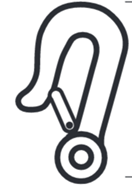
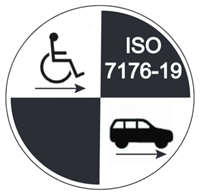
Symbols from ISO 7176-19: Indicating the positions on a wheelchair where WTORS should be attached (left) and indicating that a wheelchair conforms to the standard (right)
Wheelchair tiedowns
Wheelchair tiedowns come in a range of types from different manufacturers, but most work in a similar way.
The occupied wheelchair is moved into position within the vehicle, the wheelchair brakes are applied, and two straps are attached between the front of the wheelchair and the floor of the vehicle, preventing rearward movement of the wheelchair. Two more straps are then attached between the rear of the wheelchair and the floor of the vehicle preventing forward movement of the wheelchair. The straps are then tensioned to hold the wheelchair securely in place. The wheelchair tiedowns may feature hooks or carabiners for attaching to the wheelchair and may include a ratchet system for automatic or manual tensioning, but the principles remain the same.
The effectiveness of the wheelchair tiedowns in a collision will depend on the angles between the straps and the vehicle floor (i.e. when viewed from the side) and the longitudinal axis of the vehicle (i.e. when viewed from above). If the angles formed by the straps when the wheelchair is secured are too steep or too shallow then the forces on the tiedowns and the wheelchair may allow excessive movement of the wheelchair or the failure of components. These angles will depend on the position of the wheelchair relative to where the tiedowns are attached to the vehicle floor. The user manual for the WTORS should clearly set out the requirements of the system, however, the WTORS operator will require some knowledge of this to ensure correct positioning.
The wheelchair tiedowns can be bolted to the vehicle floor at specific, fixed positions or they can mount into rails installed in the floor of the vehicle. The advantage of mounting into rails is that the wheelchair tiedowns can easily be moved to accommodate different wheelchairs or to reconfigure the vehicle layout between journeys. The wheelchair tiedowns can also be removed completely and a fixed vehicle seat positioned in the rails instead if required. It is very important, however, to ensure that the wheelchair tiedowns are correctly and securely located in the rails, to check that none of the components are damaged, and to make sure that the placement of the wheelchair tiedowns in the rails allows the correct placement of the wheelchair each time that they are used.
Occupant restraint
Once the wheelchair has been secured to the vehicle then the occupant must be adequately restrained. It is important that there is as much clearance as possible around the wheelchair occupant to reduce the possibility of contact with vehicle components or other items in the event of a collision. Minimum distances for a “frontal clear zone” (FCZ) and a “rear clear zone” (RCZ) around the wheelchair occupant can normally be found in the wheelchair instructions for use.
Wheelchairs, including wheelchairs tested for use as a vehicle seat, are often equipped with lap belts, however, these lap belts are not adequate for use as a vehicle seat belt, not least because they do not restrain the wheelchair occupant’s torso. Instead, the occupant restraint element of a WTORS is used to provide a three-point seat belt comprising a lap belt positioned across the hips and a shoulder belt positioned diagonally across the torso. This is typically achieved by mounting seat belt components, like those found in cars to the vehicle, either at fixed locations or in rails, similar to wheelchair tiedowns.
The correct positioning of a seat belt on the body is essential to avoid injury in the event of a collision. The lap belt should sit across the hips and the shoulder belt should not sit too high or too low across the shoulder. With a WTORS, the correct positioning of the wheelchair, and the occupant restraint components if they are movable, is therefore critical to the effective performance of the occupant restraint in the event of a collision. The effectiveness of the seat belt will be compromised if the seat belt is held away from the body of the wheelchair user by parts of the wheelchair, for example the armrests or wheels.
Furthermore, the shoulder belt requires an upper anchor point that is mounted to the vehicle structure at a suitable position, normally above and behind the wheelchair occupant’s shoulder, to ensure that seat belt loads are transmitted correctly in the event of a collision. If the shoulder belt simply passes over the shoulder and directly down to the floor of the vehicle then severe compressive forces are likely to be exerted on the shoulder of the wheelchair occupant in the event of a collision and this arrangement does not satisfy ISO 10542-1.
To fully protect a wheelchair user, particularly in a rear impact collision, a correctly adjusted head restraint is essential and there are either wheelchair or vehicle mounted options available, but each type must be used according to its design and instructions.
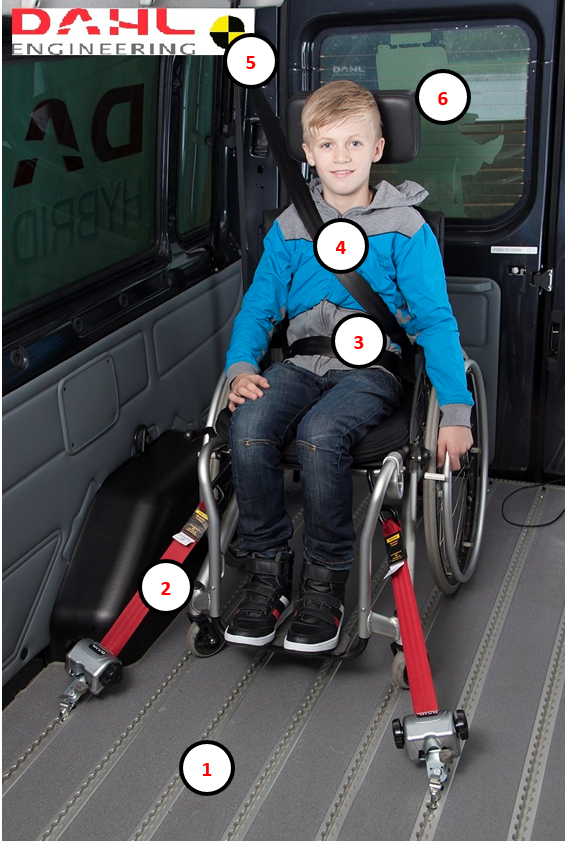
Other considerations
There are many other factors to be considered if using a wheelchair as a vehicle seat. For example, access to and egress from the vehicle using a ramp or lift, or potential interactions with vehicle airbags, although these considerations should be primarily addressed by WAV manufacturers. It should also be noted that there is another application, not discussed in detail here, where a wheelchair can be positioned on a vehicle, such as a bus, facing rearwards with the rear of the wheelchair against a suitable rest without additional restraints.
It is important, however, that in any event, users and operators of WAVs and WTORS are familiar with their correct use and take steps to ensure their required maintenance and correct use.
An illustrated example
The following are photographs of a WTORS in use in a WAV from a Hawkins investigation:
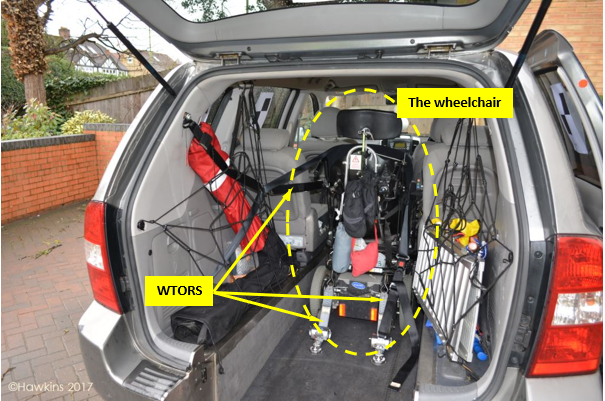
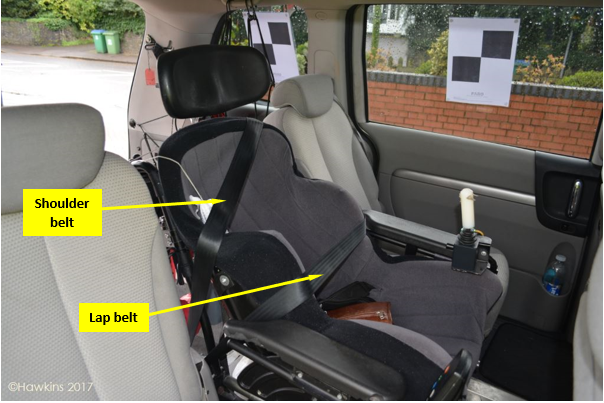
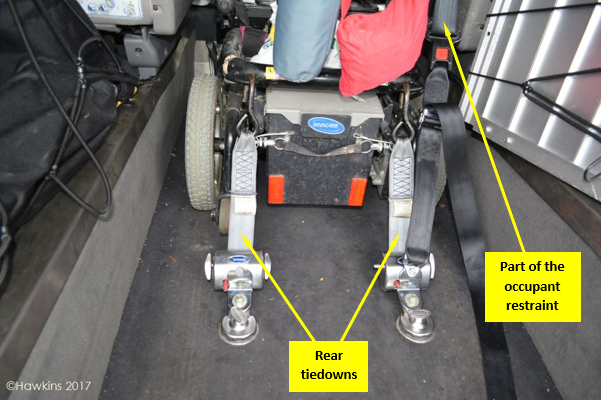
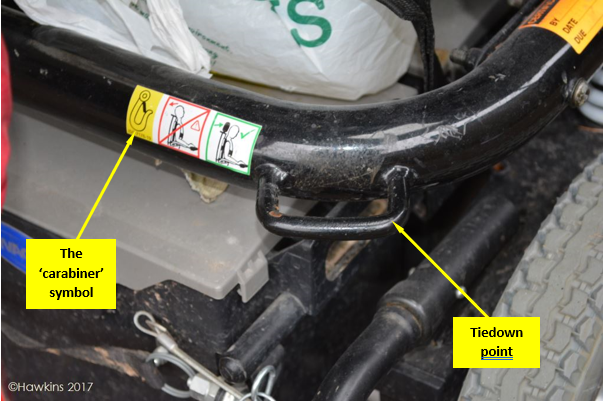
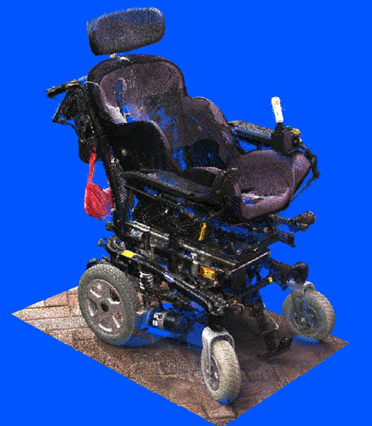
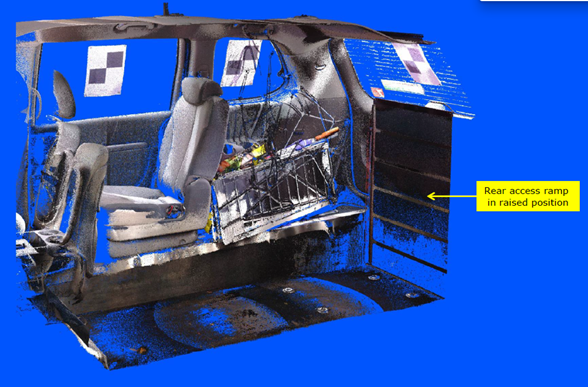
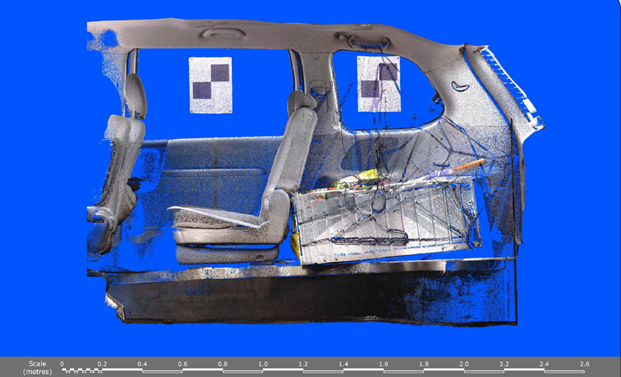
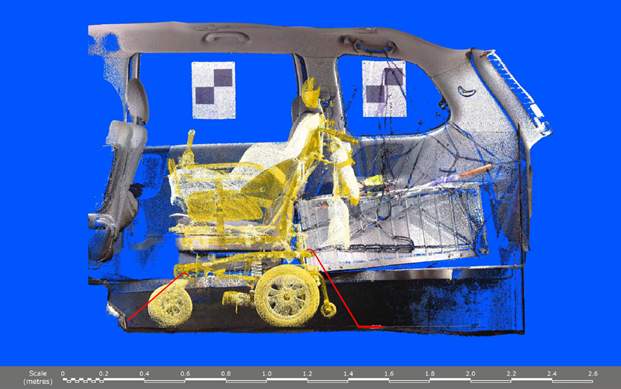
What if there is a collision?
If a wheelchair user or others sustain injuries in a collision where a wheelchair was used as a vehicle seat, it is important to investigate how the wheelchair, the WTORS and the vehicle were used. For example, were they suitable for use in the specific application; were they in adequate condition; and were they used correctly as a system? It is also important to confirm that supporting documentation, such as user instructions or procedures, were satisfactory, especially if an issue is identified with the use of any element of the system. Finally, it is essential to examine the wheelchair, WTORS and the vehicle for damage that could affect their safety or future performance, before they are put back into service.
About the Author
Gavin Dunn is a Chartered Mechanical Engineer, Member of the Institution of Mechanical Engineers and Member of the Institute of Traffic Accident Investigators, with over 13 years of experience in investigating all types of road traffic collisions from pedestrians to HGVs, including several fatal collisions where a wheelchair was being used as a vehicle seat. Much of this experience was gained with Forensic Science Northern Ireland (FSNI), attending serious and fatal road traffic collision scenes immediately and providing the forensic reconstruction of collisions from the scene right through to the court room. Gavin is experienced in analysing information from various sources such as digital tachograph systems, event data recorders, or CCTV footage and he is skilled in the examination of vehicles and their components including light bulbs and tyres. He has appeared as an expert witness in numerous criminal, civil and Coroners’ Courts. Gavin is based in Belfast and attends investigations across all of UK and Ireland.
